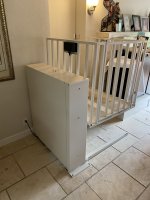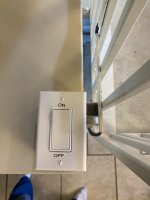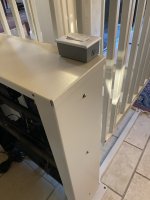Well, the lager transformer is now beginning to over heat. If I unplug and let it cool for a few hours, it will function again. Surprisingly I got a few months out of it before this happened. Now, after cooling down, I only get a few hours before it shuts down again.
I'm moving to plan 2. I'm going to install a switch on the primary. We'll just switch the entire unit off when not in use.
I'm moving to plan 2. I'm going to install a switch on the primary. We'll just switch the entire unit off when not in use.
Or maybe try to figure out what is going on? I suspect there is a dodgy component in the chair control somewhere. At minimum I would measure the load current on the secondary of that transformer to see if it is constant or creeping up over time. Is there a correlation to long term variations in line voltage?
If it was a dodgy part, it would have shown up within a much shorter period.
Was it serviced recently?
A change in weather, or ventilation, may be a window that was open is closed now.
A thermal cycling indicates a problem, that something is now a a high load.
Like above, a failing component, needs tracing.
If you have a clamp meter, see the drain with and without the motor, motor in standby. Then check again when the motor is running.
Tell us what you found, there are many experienced people here.
But it is best to use a switch on the mains supply, the circuit was 'barely meets standards' for me.
Using the transformer to run the unit, so as to stay at 24 V on the limit switches, was plain bad practice.
Look around, what you need is a reversing motor controller, with (preferably) proximity sensors, that will be reliable.
You can use this transformer for that unit, most take 5 - 32 VDC.
Was it serviced recently?
A change in weather, or ventilation, may be a window that was open is closed now.
A thermal cycling indicates a problem, that something is now a a high load.
Like above, a failing component, needs tracing.
If you have a clamp meter, see the drain with and without the motor, motor in standby. Then check again when the motor is running.
Tell us what you found, there are many experienced people here.
But it is best to use a switch on the mains supply, the circuit was 'barely meets standards' for me.
Using the transformer to run the unit, so as to stay at 24 V on the limit switches, was plain bad practice.
Look around, what you need is a reversing motor controller, with (preferably) proximity sensors, that will be reliable.
You can use this transformer for that unit, most take 5 - 32 VDC.
Last edited:
If the transformer didn't used to overheat and now it is, that's a bad sign. Something has changed that shouldn't have.
Ohh yes! It's been hot around here. I suspect that may have contributed. But as you said, "the circuit was barely meeting standards". It's either a poor design or as others mentioned, "dirty A/C" coming into the house. Either way, I think we all agreed a switch on the primary will solve the problem, not the cause and I've spent enough time trying to remedy the cause. I'm going to install the switch and put this behind me .... I hope!A change in weather
Transformer failures can be caused by voltage spikes on the AC power line. I suggest you look at a whole house spike suppressor that attaches to your main circuit breaker panel and protects the entire house.
Chicken soup solution.
Chicken soup solution.
As an emergency solution, a spike suppressor can be easily made by using a 160 V / 20 mm MOV in parallel with a 2.2R / 2W resistor in series with a 0.1 / 400 V capacitor. (Resistor in series with cap).
Attach between phase and neutral.
Don't call me out if it breaks your local rules, I am not responsible for that.
Use one on this machine, but I for one cannot understand why this simple circuit has gone bad, the relays are on AC supply, no rectifier / smoothing circuit is seen.
Just check the relay wire coil and limit switch joints, may have corrosion issues.
And no, I did not search for the panel picture, this site is slow from India.
Attach between phase and neutral.
Don't call me out if it breaks your local rules, I am not responsible for that.
Use one on this machine, but I for one cannot understand why this simple circuit has gone bad, the relays are on AC supply, no rectifier / smoothing circuit is seen.
Just check the relay wire coil and limit switch joints, may have corrosion issues.
And no, I did not search for the panel picture, this site is slow from India.
You can put a capacitor in serie of the mains of the transformer than the transformer does not get hot anymore.
https://www.amazon.com/400-480-MFD-...=d2lkZ2V0TmFtZT1zcF9zZWFyY2hfdGhlbWF0aWM&th=1
https://www.amazon.com/400-480-MFD-...=d2lkZ2V0TmFtZT1zcF9zZWFyY2hfdGhlbWF0aWM&th=1
When a small transformer draws that much current without load it could indeed be DC on the primary side.
Regards
Charles
Regards
Charles
- Home
- General Interest
- Everything Else
- Need Some Advice Regarding a Handicap Lift, Odd Transformer Issue


